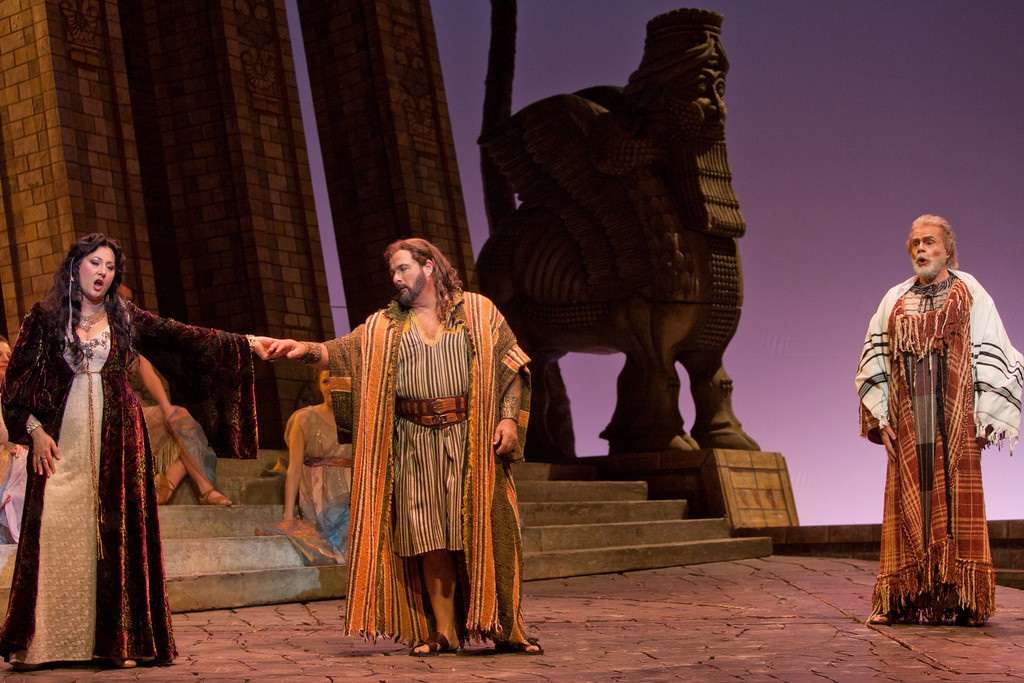|
Back
Samson is opulent but old-fashioned San Diego
San Diego Civic Theatre
02/16/2013 - & February 19*, 22, 24, 2013
Camille Saint-Saëns: Samson et Dalila
Nadia Krasteva (Delilah), Clifton Forbis (Samson), Anooshah Golesorkhi (High Priest of Dagon), Gregory Reinhart (Old Hebrew), Mikhail Svetlov (Abimelech), Doug Jones (1st Philistine), Scott Sikon (2nd Philistine), Greg Fedderly (Philistines’ Messenger)
The San Diego Opera Orchestra and Chorus, Charles F. Prestinari (Chorus Master), Karen Keltner (Conductor)
Leslie Koenig (Director), Kenneth von Heidecke (Choreographer), Charles F. Prestinari (Chorus Master).
Douglas Schmidt (Scenic Designer), Carrie Robbins (Costume Designer), Gary Marder (Lighting Designer), Steven W. Bryant (Wig and Makeup Designer)

N. Krasteva, C Forbis, G. Reinhart (© J. K. Worowicz)
In its 48-year history, San Diego Opera has presented Camille Saint-Saëns Samson and Delilah just twice. And on both occasions - in 2007 and again this month - the production featured the same Heldentenor, sets and costumes.
But the old “if it ain’t broke, don’t fix it” adage doesn’t entirely work in this year’s revival. American tenor Clifton Forbis returns in good voice, and the epic production rented from San Francisco Opera is opulent and impressive, but muddled stage direction this time around makes Samson feel old-fashioned and slow.
You can’t fault the singers in the lavish production. On the production’s second night, Forbis started out a little froggy in his Act One aria "Arrêtez, O mes frères"), swallowing his low notes but ringing and secure in the top range. But his voice opened up beautifully by Act Two, where his character, the Hebrew slave Samson, struggles between his desire for Delilah and his faith in God.
Nadia Krasteva, a Bulgarian dramatic mezzo-soprano making her company debut, impresses as the Philistine temptress Delilah. She has a rich, dusky voice with solid support from bottom to top. And although her voice has the heft to easily fill the 3,000-seat San Diego Civic Theatre, there’s no sacrifice in vocal beauty or flexibility. Her performance of the opera’s signature aria, "Mon cœur s’ouvre à ta voix," had a tonal sweetness and gentleness that well fits its words (in the song, Delilah uses false professions of love to tempt Samson to reveal the source of his divine strength).
Two other singers make strong debuts with San Diego Opera. Persian-American baritone Anooshah Golesorkhi has a big voice and an imposing stage presence as the High Priest of Dagon. And as the Old Hebrew, American bass Gregory Reinhart sings with a vibrant resonance and performs with an affecting stillness that suits his stately character.
Also well coached is the San Diego Opera Chorus, under the direction of Charles F. Prestinari. The Hebrew slaves’ aching chorus that opens the opera in ancient Gaza, "Dieu d’Israël," sets the melancholy tone for the biblical story, making their hero Samson’s arrival on the scene all the more crucial. And the chorus of Hebrew priests late in the Act One is a marvel of simplicity and beauty.
The problem with the production is its sometimes confusing direction by Lesley Koenig. Scenes that could have dramatic impact are foiled by clumsy stage blocking and artificial-looking combat.
There’s a clear and fitting emphasis on sexuality in Koenig’s production. As Samson and Delilah, Forbis and Krasteva share some passionate embraces and Krasteva bares her thigh repeatedly during her Act Two seduction scene. There’s also a clear sexual tension between Delilah and the creepy High Priest of Dagon. And in the opening scene, a Philistine temple guard grabs a Hebrew slave boy and drags him into the temple (for what purpose, the audience can only imagine).
But some awkward stage directions blunt the impact of what could easily be a much more titillating show. For example, why doesn’t the slave boy’s mother cry out when her son is abducted? Why does Koenig have Delilah and the High Priest sensually rubbing the velvet couch in her tent in the Valley of Sorek? And, most important, why does Koenig stage the opera’s most important scene - where Delilah cuts Samson’s long hair after discovering its God-given power - with the singers’ backs to the audience?
Like all French grand opera, Samson is lengthy. The San Diego Opera production runs three hours, with two 25-minute intermissions. A gripping production makes the time pass quickly. But Koenig’s often-static staging makes the pacing in some scenes feel glacial.
In the opening scene, the chorus sings their prayer in inky darkness. Lighting designer Gary Marder’s clear point was to have Samson arrive in a shaft of golden light to lead them out of their misery. But the dark lighting in the first 15 minutes of the opera doesn’t allow the audience to see the choristers’ faces, which would add much to the emotional impact of the scene.
Another missed opportunity is Samson’s battle with the Philistine temple guards and the commander Abimelech, a slow-motion fight that lacks authenticity and excitement. Granted, opera singers need to think first of their voice while performing, but some sense of drama here would establish Samson as the fearsome strongman and warrior of legend.
On the other hand, the choreography by Kenneth von Heidecke is marvelous. The sexy Bacchanale dancing in the final act is thrilling. And a brief dance interlude in Act One, where Delilah’s handmaidens swirl around Samson with gossamer scarves, is especially evocative. As Forbis’ Samson tries to leave with a Hebrew priest, the dancers tempt him with the floaty fabric, which he reaches for but can’t grasp. Then, as his temptation grows, they tighten the scarves around his waist and ensnare him, a theatrical foreshadowing of what is to come.
San Diego Opera’s Samson and Delilah is well-sung, and the voices are well balanced, but the staging lacks the drama that this very sexy story could and should possess.
Read ConcertoNet’s interview with Clifton Forbis
Pam Kragen
|